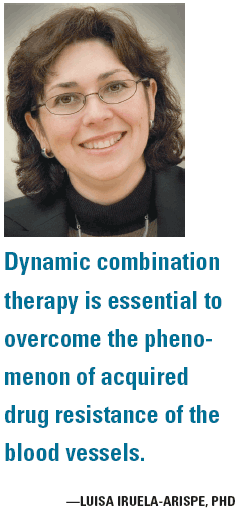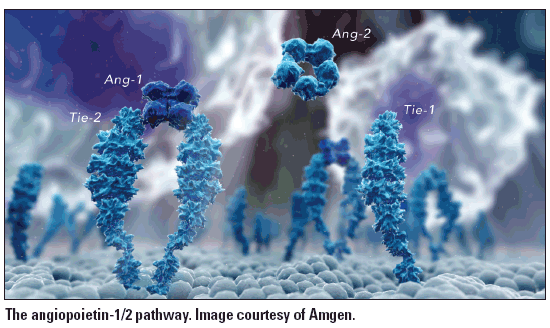New research on VEGF, gene mutations refines understanding of tumor angiogenesis
By supporting the growth of blood vessels that absorb nutrients and oxygen, angiogenesis allows tumors to progress from clonal populations to cell masses that can expand and ultimately metastasize. This is a well-established concept, but some of the premises underlying anti-angiogenic drug development are now being revised, according to Luisa Iruela-Arispe, PhD, of the molecular, cell and developmental biology department at the University of California, Los Angeles.
The underlying premises of anti-angiogenic drug development are now being revised thanks to such discoveries as the role of VEGF and the oncogenic mutations of tumors
By supporting the growth of blood vessels that absorb nutrients and oxygen, angiogenesis allows tumors to progress from clonal populations to cell masses that can expand and ultimately metastasize. This is a well-established concept, but some of the premises underlying anti-angiogenic drug development are now being revised, according to Luisa Iruela-Arispe, PhD, of the molecular, cell and developmental biology department at the University of California, Los Angeles.

Dr. Iruela-Arispe discussed future directions in angiogenesis at a teleconference held in conjunction with AACR 2009 in Denver. The four initial premises Dr. Iruela-Arispe outlined are:
• All tumors require angiogenesis to grow and metastasize;
• The process of angiogenesis, and the features of endothelial cells, are similar among tumors. Therefore, one agent is likely to inhibit angiogenesis in all tumor types;
• Anti-angiogenic therapy will not induce drug resistance; and
• Anti-angiogenic therapy will have no effect on the quiescent vasculature.
“These four premises, or molecular underpinnings, have guided the field. But now our understanding is more sophisticated and we have learned that these ideas are not necessarily correct,” she said.
VEGF family
Since the initial discovery that VEGF is a critical molecule in the regulation of endothelial cell survival, an entire VEGF “family” has emerged. Its members interact with a variety of receptors that trigger events initiating angiogenesis and the survival of epithelial cells.
The most well-established anti-angiogenic agent, bevacizumab (Avastin), blocks VEGF by capturing and sequestering the ligand, which prevents it from binding to the endothelial cells, blocking signaling and thereby inhibiting the progression of angiogenesis. In the pivotal late-stage metastatic colorectal cancer trial NSABP C-08, the addition of bevacizumab to chemotherapy improved survival by about five months. The study validated the relevance of pursuing angiogenesis as a treatment for cancer (N Engl J Med 350:2335-2342, 2004).
Initial enthusiasm over the findings in the metastatic setting was tempered somewhat by the observation of bevacizumab’s toxicity profile (primarily hypertension and arteriothrombolic events) and the realization that anti-VEGF therapy does not replace chemotherapy. Also, Roche and Genentech recently announced that bevacizumab did not improve disease-free survival in a phase III adjuvant trial.
Tackling tumors
“With aggressive anti-angiogenic therapy, we suppress the size of the tumor but we don’t kill it,” Dr. Iruela-Arispe pointed out.
When the tumor vasculature is destroyed, cells obtain nutrients from vessels in the periphery. In other words, they co-opt existing vessels and angiogenesis is stimulated through hypoxia. Anti-angiogenesis therapy must be used, therefore, in conjunction with chemotherapy.
“We still must tackle the tumor cell itself, because it will continue to invade the tissue to seek out new blood vessels,” she said at the Amgen-sponsored teleconference. Researchers now also discount the premise that one anti-angiogenic agent will be effective in all types of tumors.
“Endothelial cells from tumors share common features, yet there are differences among tumor vessels and some anti-angiogenic therapies are more effective in some tumors than in others,” Dr. Iruela-Arispe said.
The therapy’s effect on tumor vasculature varies according to the tumor type and the oncogenic nature of its mutations. Tumor-derived endothelial cells contain genomic alterations and develop genomic instability. Genetic insults affect blood vessels, the recruitment of inflammatory cells, and the gene expression profile within the endothelial cells. The challenge is to match the genetic profile of the tumor to the anti-angiogenic therapy, she noted.
Also now disowned is the presumed lack of acquired resistance to anti-angiogenic treatment. The development of resistance may be one explanation for the less dramatic effects seen in humans, as compared with preclinical models. In some cases, even normal endothelial cells within tumors have high potential to develop drug resistance, providing further evidence that these agents must be partnered with other interventions.

“The process of angiogenesis is biological. Therefore, dynamic combination therapy is essential to overcome the phenomenon of acquired drug resistance of the blood vessels,” she said. Furthermore, while the tumor is more susceptible than its surroundings to anti-angiogenic attack, contrary to initial belief, there is some effect on the quiescent vasculature.
In animals, prolonged exposure to anti-VEGF treatment leads to capillary loss, reduction in endothelial fenestrations within the renal glomerular capillaries, and regression of thyroid capillaries. In preclinical models, removal of VEGF from the endothelial compartment of cells also results in cell apoptosis and death.
“We believe, therefore, that we may not only be impacting tumor vasculature, but, to a lesser degree, the nearby normal vessels,” she said.
Other modalities or combinations administered at lower doses may someday prove to be more effective within the tumor vessels and less deleterious to the normal vasculature, she predicted. Future challenges in the development of anti-angiogenic therapies are to better understand the mechanisms of vessel growth, vascular heterogeneity in organs and tumors, and the interaction between tumors and stroma; to explore novel therapeutic targets; to determine optimal combinations of agents; and to develop efficient imaging techniques to aid basic science and therapeutic efforts.